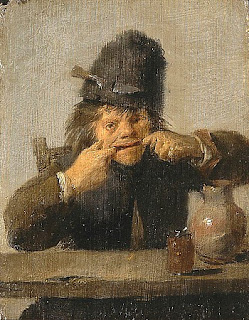 |
| The Smoker, 1635-38, Joos van Craesbeeck, an example of a tronie. |
 |
| Youth Making a Face, 1632-35. Adriaen Brouwer |
It's not every day I stumble upon a term regarding art that mystifies me. Does anyone reading this know what a "tronie" might be. I just noticed that my spell-checker is as curious about the word as I was. The term has its origin during the Dutch Golden Age during the 17th century. A tronie is a painted face with an exag-gerated facial expression or a stock char-acter in costume. The Smoker (above), is a humorous example of a tronie, by Joos van Craesbeeck dating from around 1635-38. Youth Making a Face (left), by Adriaen Brouwer, is another good example. How-ever, It's just as important to note that a tronie is not usually a portrait, or of any identifiable individual (though some of Rembrandt's are, but only because he used his wife, Saskia, as a model). You might think of a tronie as what a Dutch portrait painter did when he got bored.
 |
| Tronie of a Young Woman, 1640-45, Govert Flinck |
That probably pretty well describes the situation with the Dutch painter, Govert Flinck. For the most part, Flinck spent his time trying to paint as well as his master, Rembrandt van Rijn. One of his earliest surviving works is, in fact, a Portrait of Rembrandt (bottom) painted around 1633-34. He has long been considered one of Rembrandt's best students. Flinck followed along the lines of Rembrandt, in all the works which he executed between 1636 and 1648. His Blessing of Jacob (above-top) from 1638 compares very favorably with a later version of the same subject by Rem-brandt (above-bottom), which begs the question as to who was following whom. The Flinck's Tronie of a Young Woman (right) demonstrates that not all Tronies involved exaggerated expressions. In mid-career, around 1648, having aspirations as a history painter, Flinck began looking to the swelling forms and grand action of Peter Paul Rubens, which led to many commissions for official and diplomatic painting.
Govert Flinck was born in 1615 near Kleve, then the capital of the Duchy of Cleves, now on the far western border of Germany with the Netherlands. His father was a merchant and importer of silks and other dry goods. As was the custom of the time, young Govert was initially apprenticed to his father, but had such a passion for drawing he was sent to Leeuwarden, (now in the Neth-erlands) where he boarded in the home of Lambert Jacobszoon, a Mennonite, better known as an itinerant preacher than as a painter. Among their neighbors was the father of Saskia van Uylenburgh, who in 1634 be-came Rembrandt's father-in-law.
Once a Dutch artist in Amsterdam began to make a name for himself, as Flinck did during the 1640s, he could take advantage of the Dutch passion for group portraits. Flinck's Militia Company of District XVIII under the Command of Captain Albert Bas (below), of 1645, is typical of his work, and that of most other accomplished portrait artists of the time (including Rembrandt's) and better than many of them. Flinck died in Amsterdam in February 1660 at the age of forty-five.
 |
| Angels Announcing the Birth of Christ to the Shepherds, 1639, Govert Flinck |
 |
| Govert Flinck, Self-Portrait, 1640 |
 |
| Militia Company of District XVIII under the Command of Captain Albert Bas, 1645, Govert Flinck |
 |
| Apostle Paul, 1639, Govert Flinck. |
 |
| Rembrandt as Shepherd with Staff and Flute, 1635, Govert Flinck. Were this not identifiable as Rembrandt, it might be considered a tronie. |
 |
| Portrait of Rembrandt, 1633-34, Govert Flinck |

No comments:
Post a Comment